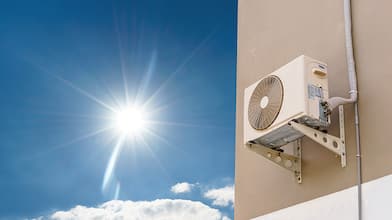The typical range for installing a new central air conditioning unit costs between $3,800 to $7,500
In the hot summer months, having an AC unit isn’t just a luxury—it’s a lifesaver. If your cooling system isn’t working at its best, upgrading your AC unit or even installing one for the first time can be a gamechanger. Newer central AC units are quieter, more powerful, and more energy-efficient than older models, and they can offer greater value by helping to lower energy bills each month.
But each step up the cooling ladder comes with an equivalent cost. Factors including the type of unit you choose, the cost of labor, and additional tasks like ductwork repair or pouring a new concrete pad could all impact the final cost of your installation project.
How Much Does It Cost to Install a New AC Unit Near You?
Prices can vary city-to-city based on the area’s climate, the size of your home, the cost of materials to do the project, and the individual HVAC contractor you hire.
San Diego: $6,170
Denver: $4,640
Austin, TX: $5,840
Madison, WI: $4,360
Atlanta: $4,515
Philadelphia: $6,350
What New AC Unit Can I Get on My Budget?
You can expect to pay $1,500 to $4,000 for the air conditioning unit itself, but expect the cost of labor and installation to increase that number when you’re budgeting for the project overall.
$4,000
For a basic, 2–ton model, expect to pay $3,000 to $4,000 with labor.
$5,000
A mid-range AC unit will run approximately $5,000 with labor.
$8,000+
Top-of-the-line AC systems can potentially creep up over $10,000 with labor. The absolute high-end cost is around $11,000.
The size of the AC unit, the brand you purchase, and HVAC contractor you choose will factor into these budget estimates as well. For example, brands like Payne, Coleman, and Comfortmaker tend to be on the low end at less than $2,000, while brands like American Standard, Carrier, and Lennox are on the high end over $3,000.
Reduce Costs by Earning Tax Credits and R-22 for New AC Units
It's possible to find rebates or tax breaks from federal or state agencies to offset the cost of air conditioning. Unfortunately, federal tax credits expired at the end of 2013 for residential systems that are ENERGY STAR-rated and aren't part of a new home build. You can check the ENERGY STAR website for current tax credit information.
State governments may offer rebates if you install a particularly high-efficiency system, but they are often limited in duration. It's worth doing some research into your own state’s rebate options before you hire a professional air conditioning company.
In addition, air conditioning manufacturers are phasing out the hydrochlorofluorocarbon (HCFC) known as R-22, which is an ozone-destroying greenhouse gas. As of 2015, R-22 production has gone down by 90%.
Under current regulations, manufacturers may no longer produce, and companies may no longer install new AC units that contain R-22. Companies can still manufacture new parts, such as condensers with R-22, for replacement in existing units.
How Much Does It Cost to Install a New Air Conditioning Unit Yourself?
This is not a job you’ll want to tackle on your own. While it's possible to purchase an air conditioner from a wholesaler and install it yourself, it requires some serious skill to do it correctly. Also, you must be certified by the Environmental Protection Agency (EPA) to handle refrigerants. It is generally safest to hire a state-licensed local HVAC contractor to do the installation for you.
For homes that have never had central AC, an installation requires new breakers in your electrical panel, wires run through your foundation, new duct work linking to your existing HVAC system, framing and finishing areas where ductwork is needed for the second floor or higher, and the mounting of your unit on metal brackets or a concrete pad.
How Much Does It Cost to Install a New AC Unit by Type?

Depending on your living situation and budget, there are a variety of different AC systems to consider. Some units may come with a higher price tag, but usually provide better cooling and last longer than the less expensive solutions. Before you decide which type of AC unit is right for you, consider the cost and pros and cons of each.
Central Air System: $3,815–$7,480
Ductless Split System: $2,000–$14,500
Window Air Conditioner: $150–$500
Portable Air Conditioning Unit: $90–$500, similar to a window AC unit
Central air and ductless split systems are the most costly options, but also the most energy efficient and long-lasting. Central air is common throughout the country and typically lasts between 10 to 20 years before it needs replacing. Benefits of a ductless AC system include low-maintenance upkeep, no need for ductwork (which can be expensive to repair or replace) and quiet operations compared to central AC.
Window air conditioners work well for smaller spaces and for homeowners or apartment dwellers who haven’t budgeted for a larger central AC system installation.
Portable air conditioning units, a.k.a “swamp coolers”, are not true AC systems, but are able to cool larger homes on a much less expensive budget and with less energy consumption than central air or ductless split systems. Plus, you can move them around as needed, which can be helpful for families that own multiple residences or often spend time in an uncooled outbuilding, barn, or mobile home. Since air conditioners also dehumidify the air, they will collect water. In arid areas, the water will evaporate, but in humid areas, you will need to empty the reservoir periodically.
What Factors Influence the Cost to Install a New Air Conditioning Unit?
Several factors can increase the cost of your air conditioner installation. If you need a new thermostat, for example, or if the design of your house requires substantial amounts of ductwork to link with your existing furnace, you'll pay more than average. Typical air conditioning costs mostly depend on whom you hire, what size system you need and your AC unit's overall efficiency.
Size of the Air Conditioning Unit
The first step in getting a new air conditioner unit installed is determining what size you'll need. You don't want one without sufficient power to cool your home, and getting an air conditioner that's too big can be more expensive and less comfortable.
AC units are measured in tons, which refers to the amount of heat they can remove from a home in one hour. A 1-ton unit, for example, can remove 12,000 British thermal units (BTUs), while a 3-ton system will remove 36,000. The larger your house, the more cooling power you'll need: A 1,600-square-foot house, for example, might be well served by a 2-and-a-half-ton unit. The general rule is that every 500 or 600 square feet requires one ton of cooling.
"Many people are tempted to buy larger units for faster cooling,” says Bob Tschudi, Angi Expert Review Board member and general contractor in Raleigh, NC. “But the result can be higher electric bills, inconsistent cooling, higher humidity and, in some cases, mold. Your HVAC contractor will calculate the exact size unit for your living space."
However, many other variables factor into which size air conditioner will work best in your home. Factors like the shape and orientation of your home matter, too. For example, a basement is naturally cooler than first- or second-floor rooms. Rooms with high ceilings also require more conditioning or the addition of ceiling fans to better circulate air.
Hiring an AC Contractor
You'll want to ensure a crucial task like this is done correctly, so avoid wasting time (and potential injuries) and ask a reputable AC pro for a free quote on your system. This way, you’ll be able to enjoy your home in ultimate comfort sooner without the headaches involved with needing an AC repair job later.
Your Air Conditioner’s Seasonal Energy Efficiency Ratio (SEER)
The seasonal energy efficiency ratio (SEER) is also a critical factor. This ratio measures an AC unit's total cooling output (measured in BTU) during a season, divided by its total electric energy input. The higher the resulting number, the better. Currently, all units sold are over 13 SEER, and some can perform at up to 27 SEER.
The advantages of improved SEER ratings are lowered energy costs and cooling times, but they come with a corresponding cost increase for the new unit and installation. If your hot weather season isn't particularly long, the increased price may not be worth it. But if you need to replace a broken AC unit with a new one anyway, this may be something to keep in mind to help offset your energy bills in the long term.
FAQs About Installing a New Air Conditioning System
How often should my air conditioner be serviced?
To keep your AC unit in good working condition, you’ll want to have a service technician do an inspection and get your AC unit tuned up often—at least once per year. A great DIY option is to clean the evaporator coils at least once a year (preferably before summer).
Should I repair or replace my air conditioning system?
A variety of factors influence whether it is best to repair or replace your air conditioner, including:
Age of your AC unit (most HVAC technicians say to replace if your unit is 15 years or older and to replace both units at the same time if you have an indoor and outdoor unit)
Energy efficiency (would a replacement make a significant change in the cost of your energy bill over time?)
If your existing AC is broken, consider the extent of the damage and the associated costs with fixing it (is the cost to repair your AC unit almost the same as it would be to just replace it with a new one?)
Can I make my air conditioner quieter?
Luckily, it IS possible to quiet a noisy air conditioner. Louder units can run over 80 decibels on a hot day, which can feel painfully loud up close.
Many municipalities have passed laws that require new installations to be under a certain decibel level. At 75 decibels, for example, you'll probably hear the unit from the garage or through a window on the same side of the house, while at 70, it will begin to fade into background noise. Most popular brands offer high-efficiency, low-noise models for an increased price.
Tschudi also noted that some municipalities require homeowners to build a fence around their external air conditioning unit, which can also reduce noise.





